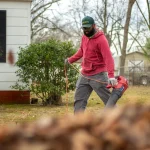Table of Contents
- Regular Inspections
- Cleaning Gutters
- Removing Debris
- Addressing Leaks Promptly
- Trimming Overhanging Branches
- Checking for Moss and Algae
- Inspecting Flashing
- Maintaining Roof Ventilation
- Choosing the Right Roofing Material
- Hiring a Professional
Regular Inspections
Regular roof inspections are crucial to spotting issues early. Aim for at least two inspections per year, especially after severe weather. Look for damage and weak spots to extend your roof’s lifespan and save money. If you need help performing a proper inspection, you can consult a roofing company specializing in roof maintenance and repair. Professionals have the trained eye and expertise to catch what might go unnoticed.
Cleaning Gutters
Gutter cleaning is an essential part of roof upkeep. Gutter debris buildup can result in water backup and possible leaks. It’s important to remember to clear your gutters periodically, particularly in the fall and spring. If gutters are not cleared, they may cause serious structural issues and be annoying. A clogged gutter’s water overflow can harm your home’s foundation, fascia boards, and soffits. Frequent cleaning helps to prevent potential water damage by ensuring that water drains quickly away from your walls and roof.
Removing Debris
Keeping your roof free of debris, such as leaves, branches, and dirt, helps maintain its longevity. Use a roof rake or a blower to remove loose materials that could retain moisture and cause damage. Debris can also attract pests, which can create further complications. For instance, accumulated leaves can trap moisture against the roof surface, leading to rot, mold, and algae growth. Removing debris regularly helps to maintain a clean and dry roof, reducing the risk of long-term damage.
Addressing Leaks Promptly
Ignoring small leaks might lead to more significant issues down the road. If you see any damp patches on your ceiling or walls, investigate and address the source immediately to prevent further damage. Even tiny leaks over time might result in mold growth and structural damage. Acting quickly may save money on repairs and keep your home comfortable and safe. Ignoring water damage can lead to structural deterioration of your roof and more complex, costly repairs.
Trimming Overhanging Branches
Overhanging branches on your roof can draw in insects and cause harm. Regularly trimming these branches can reduce potential damage and the amount of unwanted debris on your roof in the future. Prevent accidents by completing this task in a safe manner or by enlisting the help of a professional. Overhanging branches may exert pressure on the shingles, leading to the loss of granules and damaging the material underneath due to weathering. Removing limbs from the rooftop improves its overall stability and protection.
Checking for Moss and Algae
Moss and algae can weaken roofing materials over time. You can use moss and algae removal products or hire a professional to clean them off without damaging your roof. Learn more about the adverse effects of moss and algae on roofing materials and how to combat them effectively. These organisms retain moisture, leading to rot and deterioration of roofing materials. Cleaning them regularly helps preserve the roof’s functionality and aesthetics.
Inspecting Flashing
Flashing seals and protects roof areas where shingles meet other materials, such as chimneys and vents. Ensure your roof’s flashing is intact and properly sealed to prevent water infiltration. Damaged flashing can easily lead to leaks if not addressed promptly. Regularly inspect the flashing for cracks, rust, or lifting, and make necessary repairs or replacements to maintain a watertight seal.
Maintaining Roof Ventilation
Proper ventilation is essential for controlling attic temperatures and avoiding moisture buildup. Verify that the vents on your roof are clear of obstructions and operating correctly. This can increase home energy efficiency and prolong the life of your roof. Inadequate ventilation also results in higher energy expenses and decreased home comfort. In colder areas, adequate ventilation facilitates airflow and keeps ice dams from forming, which lowers the possibility of mold and mildew growth.
Choosing the Right Roofing Material
Durability depends on selecting the suitable roofing material for your climate and home design. To make a well-informed decision:
- Examine various materials, such as tile, metal, and asphalt shingles. The pros and cons of different roofing materials assist you in making an informed decision.
- Make an informed choice since it will impact your roof’s lifespan and maintenance needs.
- When choosing, consider factors like lifespan, cost, weather resistance, and visual attractiveness.
Hiring a Professional
While maintaining your home can reduce costs, having a professional handle yearly inspections and significant repairs guarantees the work is done correctly. Experts have the knowledge and experience to see problems that others might miss. They can also offer comfort in knowing that your roof is in top shape. Experts can conduct comprehensive checks and repairs with the proper equipment and safety gear, guaranteeing any possible issues are quickly resolved.







